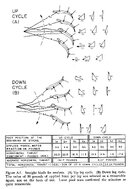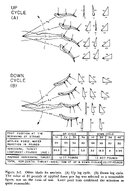(...it's after supper.)
During supper, I re-read a chapter that Fred Roberts wrote in Basic Scuba titled "Swim Fin Analysis, Addendum to Chapter 9." In it he gives one of the best descriptions of vector analysis of swim fins that I've seen written anywhere. That is probably the engineer in him coming out. I also looked again at both the Duck Feet fins that I have and the Force Fin. This gave me insights into the physics of swim fins that may be helpful in describing what the Force Fin does. I'll await another time to do that analysis though, but did confirm that the Force Fin bending occurs behind the toes (toward the ankle), and not in front of the toes as in most fins.
As I said above, I have now done five scuba dives with Force Fins, four in the Clackamas River and one in the Columbia River. The last, in the Columbia River, was just a day ago. It was during the noon hour, and only 15 minutes long off a sandy beach into about 10 feet of water and a mud bottom. I saw some interesting close-ups of tiny tube worms, and a bivalve mollusk, but not much else. However, my fourth dive in the Clackamas River was after work last week, and I had forgotten my wet suit top. So I dove in only my swim suit and a T-shirt (67 degree water, and I have enough blubber of a 1/2 hour dive). But the other thing I forgot was my booties. I talked down to the river barefoot, put the fins on, and commenced with a half-hour dive. So I dove the Force Fins with an old half-foot sock I cut from my worn-out booties. During the dive I again pursued fish, and caught up with a few too. My exit spot was downstream, and consisted of climbing out of the river at a small park. The river bank was rocks, and the climb was about twenty-five feet vertical to the grass, then the rest of the way walking up a bike path to my car. Well, I was not too sure about doing this barefoot, so I decided to see how the Force Fin would do on land. I was able to climb up some rather steep areas, with small foot holds, with the Force Fins still on! I would not have even attempted this with any other fin, especially with the webbing on my scoop fin design. These other fins only negotiate land backwards. But I walked clear to my car (over 100 yards, and probably forty vertical feet) with the Force Fins on. My feet, well protected, approved.
I'll write some more over the weekend on what I see as the physics of the Force Fins, my scoop fins and the split fins which may look a bit different from what others have discussed before. But one part of these fins is undisputed--that I can walk and climb on land with them.
SeaRat
 anicbutton:
anicbutton:




